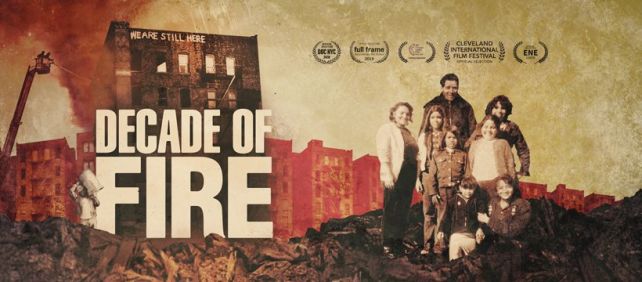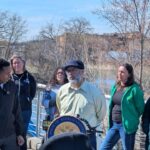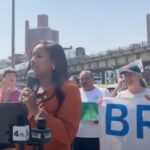Home is one of the greatest forms of security a person can have. But what happens when a person lives their life, knowing their safety could feasibly get destroyed at any moment? Unfortunately, this was the reality that residents of the South Bronx faced between 1970 and 1980. In the PBS documentary, Decade of Fire, the story behind the burning buildings of the South Bronx is unraveled.
During the 1970s, houses of the South Bronx were ablaze. 80% of housing was lost to fires, and 250,000 people were displaced. In contrast, the state pool insurance payout was 10 million dollars, which is approximately 50 million dollars today. Nonetheless, the narrative that was pushed by the media (and prevails to some degree today) was that the destruction was the fault of the residents. Vivian Vázquez Irizarry, who grew up during this period, wanted to disrupt this narrative. The film is thereby her pursuit of the real history behind the Bronx’s fires.
Irizarry’s story started when her grandparents immigrated to the heart of the Bronx from Puerto Rico for job opportunities. The South Bronx was notably different from what it is known as today. America was plagued with segregation during the 1950s. The South Bronx, however, was amongst the most culturally integrated neighborhoods in the country. The diverse backgrounds produced a variety of music, which they knew as “music wars.” It was for the people to enjoy and immerse themselves in.
What made the South Bronx a music center had also made it a target of discriminatory policies. Redlining, for one, is a practice that had started as early as the 1930s. Any neighborhood that had a 5-10% Black or Puerto Rican population was seen as detrimental. A red line would be drawn on a map around these places, indicating that they should not be eligible for loans, home insurance, or fire insurance. Given how the South Bronx housing stock was already old, redlining only worsened the conditions that people lived in by encouraging disinvestment of the area and depriving residents of the capital needed to adequately maintain their homes.
Urban renewal was also a tactic that harmed the South Bronx. It was described as the tearing down of “slums” in Manhattan to replace it with middle-class housing and civic centers. In the words of James Baldwin, it was actually “Negro removal.” Over 100,000 homes were demolished, and a portion of the former tenants were displaced into the South Bronx. It was easy for White people to leave for the suburbs, with the government subsidizing it. On the other hand, Black and Puerto Rican people were not afforded these same opportunities.
Landlords sold their buildings to speculators and divided the apartments to create more homes, increasing density and limiting space. The circumstances people lived under were beginning to reap their effects. A lot of people ended up in difficult situations, ranging from drugs to death to crime. Eventually, all of these resulted in the fires of the South Bronx.
1968 was when the fires were on the rise, yet the fire department’s response was totally inadequate. Sometimes, they would come after the buildings had already been destroyed. Other times, they may not have come at all. Because NYC was bankrupt, 12 fire companies were closed in the South Bronx from 1974-1976. Then the blackouts of 1977 had happened, collapsing entire areas.
The devastation of the fires was underrepresented. People would wake up frantically crying and screaming to their homes being destroyed. Some went as far as to jump on mattresses to simply escape. By the 1970s, every building had seen a fire at least once. At least half the fires were not even recorded just because of how many there were.
What the South Bronx needed were more fire marshalls. Yet it was not only bankruptcy that stood in the way of obtaining help. More fire marshalls were demanded, yet The Office of Management and Budget said the fire marshalls would not solve the problem of arson.
But why would anyone want to burn their own home? The media made it sound like the residential kids were interested in arson and how nefarious they were. But the landlords who paid for their buildings to get torched were never the topic of discussion. There were virtually no consequences for this since landlords did not have to fix the buildings. They could simply take the money and walk away. For example, in 1980, Lloyd’s of London (a home insurance company) was paid $45 million dollars. This is the same as $250 million dollars in 2018. The only reason this was known because of a federal investigation. Many of these fires, in fact, needed such examination. But because they were labeled as “cause unknown,” they never received one.
Hope briefly came when President Jimmy Carter had come to the South Bronx, seeing the precariousness people had been living under. He wanted to renovate the South Bronx “block by block.” He pledged a $55.6 million dollar deal to save it.
But the money never arrived. Even worse, Ronald Reagan came into office. He did not believe any government program could ever repair the South Bronx and only worked to take away money from existing ones that could potentially help.
Fort Apache, The Bronx (1981) is a film that told the South Bronx fires’ stories. It only further perpetuated the racist stereotypes and false narrative that the fires were the people’s fault within the Bronx. And at this point, the people of the South Bronx were fed up. Grassroots organizations used culture, community, and music to reshape the area. Old buildings were maintained so after school programs could take place. Local community members trained people on how to reconstruct buildings. They invested their labor for no price other than providing their home the opportunity to flourish. An arson investigation team was finally assigned to the Bronx in 1982 from local pressure. The fires had slowed down as a result. In 1986, mayor Ed Koch had funded a $4.4 billion dollar program to rehabilitate 100,000 housing units.
Irizarry had envisioned leaving the Bronx when she was 15 years old. When she left for college to SUNY Albany, she could not help but visit her roots. She recruited other kids to go to college. To this day, she works in public schools to encourage students to do the same. She wants people to be proud and uplifted by the story of the Bronx. This includes her children, one of which is featured in the film. Irizarry talks to him about her life and shows him pictures from her childhood.
The Bronx fires are a multi-faceted part of history. It is undoubtedly a tale of people’s ability to fight for themselves and rise beyond grim circumstances. What must be emphasized, however, is the failure of the government to care for its people. The Bronx residents were victims of fundamentally racist and classist policies that were sugarcoated as an improvement. In addition to that, the blame was placed on them. They had lost their lives, their loved ones, their homes, and so much more. To recenter their story on anything but that is unjust. More importantly, the fight is not over. Now, the Bronx is getting gentrified and long time residents who rebuilt the borough are being displaced. Action is needed once again to protect the Bronx and its residents.






